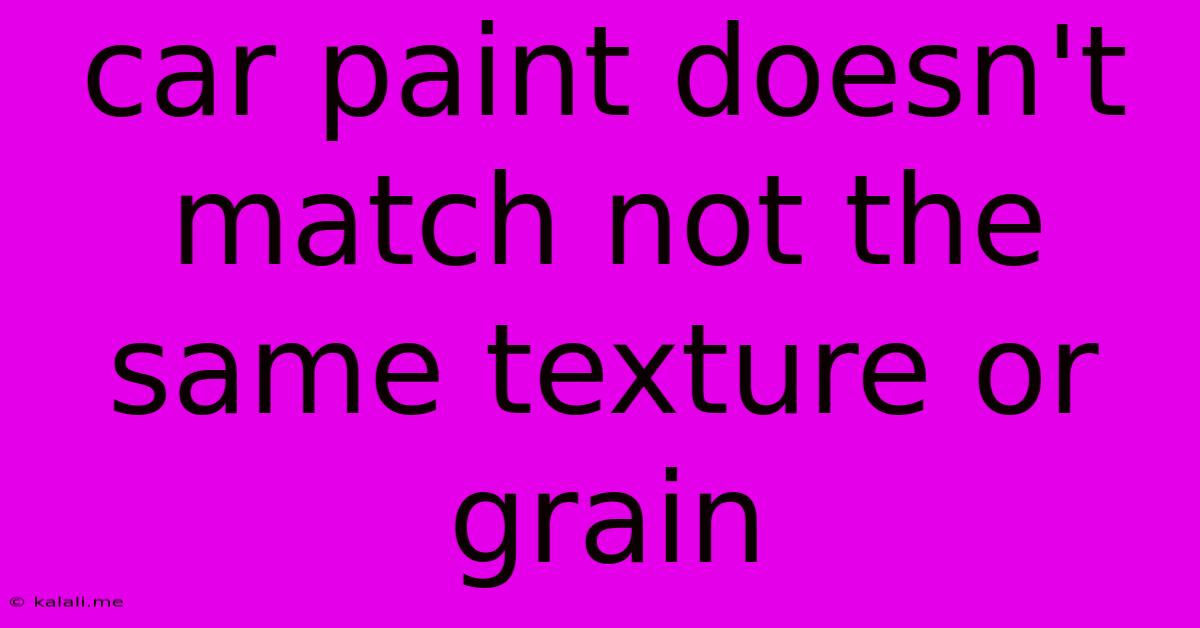Car Paint Doesn't Match Not The Same Texture Or Grain
Kalali
Jun 04, 2025 · 4 min read

Table of Contents
Car Paint Doesn't Match: Troubleshooting Texture and Grain Discrepancies
Meta Description: Dealing with mismatched car paint? This guide helps diagnose issues with paint texture and grain inconsistencies, offering solutions for achieving a seamless, professional finish. Learn about potential causes, from improper preparation to paint type mismatch, and how to fix them.
Have you ever had a car repair where the new paint simply doesn't match the existing finish? It's frustrating to see a noticeable difference in color, but even more so when the texture and grain of the new paint are visibly different from the original. This mismatch can significantly detract from your car's appearance, making it look less professional and even lowering its value. This article will explore the common reasons why your car's repainted areas might exhibit texture and grain inconsistencies and offer solutions for achieving a better match.
Common Causes of Mismatched Car Paint Texture and Grain
Several factors can contribute to a mismatch in paint texture and grain following a repair. Let's examine some of the most frequent culprits:
-
Improper Surface Preparation: This is perhaps the most significant reason for a mismatch. If the old paint isn't properly sanded, cleaned, and primed before applying new paint, the resulting finish will inevitably differ. Insufficient sanding can leave behind imperfections that show through the new coat. Contaminants on the surface can also prevent the new paint from adhering correctly. Proper surface preparation is crucial for achieving a smooth, even finish.
-
Incorrect Paint Type or Formulation: Using the wrong type of paint – for example, using a different brand, type of automotive paint (e.g., acrylic lacquer versus urethane), or a different finish (e.g., metallic versus solid color) – can lead to texture differences. Different paint formulations have varying drying times and can result in different levels of gloss and texture. Ensure the repainted area uses the same paint type and brand as the original. Even within a specific paint type, subtle variations exist that affect final texture.
-
Application Technique: The application technique significantly impacts the final paint texture. Incorrect spray gun settings, too much or too little paint, and inconsistent application pressure all can create an uneven finish. Furthermore, the number of coats applied can influence the texture. Too few coats might leave the underlying surface showing through, while too many coats can lead to a thick, uneven finish. A professional painter will have the necessary expertise and equipment to achieve a consistent finish.
-
Environmental Factors: Environmental conditions during painting can affect the final texture. High humidity or extreme temperatures can hinder the drying process and lead to an uneven, possibly unevenly textured finish. Dust or debris in the air can also settle on the wet paint, causing imperfections. Ideally, painting should be done in a controlled environment, or during periods with the least possible wind.
-
Clear Coat Application: The clear coat is crucial for the overall finish. Incorrect application, incorrect clear coat type for the base coat, or even imperfections in the underlying paint layers can all affect the final texture. Uneven clear coat application can lead to orange peel effect, a very common problem in mismatched paint jobs.
Solutions and Prevention Strategies
To prevent mismatched paint textures and grains, and to correct any existing issues, consider these strategies:
-
Thorough Surface Preparation: Invest time in proper surface preparation, including thorough sanding, cleaning, and priming. This is the foundation of a successful paint job. Consider using appropriate fillers and leveling agents to address existing imperfections on the surface.
-
Choosing the Right Paint: Match the paint type, brand, and formulation precisely to the existing paint on your vehicle. If in doubt, consult a professional automotive painter or the paint supplier. Consider using a color matching service if you're unsure of the exact paint code.
-
Professional Application: Consider hiring a professional automotive painter. Professionals possess the expertise, tools, and equipment necessary to achieve a consistently smooth, even finish and will have the expertise to tackle complex situations such as the matching of a metallic automotive paint job.
-
Controlled Environment: If you're painting yourself, ensure that you do so in a clean, controlled environment to minimize the risk of dust or debris settling on the wet paint. Consider controlling temperature and humidity levels for optimal paint curing.
-
Multiple Coats with proper drying: Ensure proper drying time between coats. This is essential to avoid problems with texture and grain consistency. Applying too much paint at once or too few layers is equally problematic.
By addressing these aspects carefully, you can significantly improve the chances of achieving a seamless and consistent finish on your car's repainted areas. Remember that perfect matching can be difficult, but a thorough approach can minimize any discrepancies and ensure a professional finish.
Latest Posts
Latest Posts
-
Can Commutative Property Be Used For Subtraction
Jun 06, 2025
-
Is Bingo The Dog Or The Farmer
Jun 06, 2025
-
How Do I Know If I Have Perfect Pitch
Jun 06, 2025
-
Can I Replace Only One Tire
Jun 06, 2025
-
Danger Of Using Ground As Neutral
Jun 06, 2025
Related Post
Thank you for visiting our website which covers about Car Paint Doesn't Match Not The Same Texture Or Grain . We hope the information provided has been useful to you. Feel free to contact us if you have any questions or need further assistance. See you next time and don't miss to bookmark.